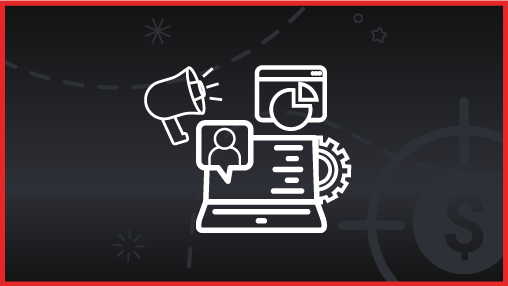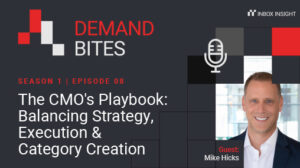Struggling to gauge your lead generation success? You’re not alone. The solution is identifying the appropriate Key Performance Indicators (KPIs). These KPIs reveal the actual performance and potential return on investment of your lead generation efforts.
Lead generation KPIs filter out less meaningful metrics, such as page views or social media followers, directing focus to the factors that truly influence your revenue.
Here’s why paying attention to these metrics is non-negotiable:
- Sharpen your approach: Pinpoint which sources, campaigns, and types of content are hitting the mark. By understanding what works, you can dial in on winning tactics, ditch the duds, and optimize both your budget and efforts
- Spot opportunities: A bird’s-eye view of your KPIs can reveal weak spots—be it a stall in conversion rates, hefty costs per lead, or other sluggish indicators. Once you know where the problem lies, you can zero in and turn things around
- Measure gains and growth: Tracking these metrics over time stands as proof of your strategies’ contribution to the company’s financial health. If you want concrete evidence of value, KPIs are your go-to
If you’re considering outsourcing your lead generation, it’s crucial to choose a partner that offers more than just expertise. The right partner will provide a highly efficient system that optimizes your operations and significantly enhances your results.
KPIs are vital tools—not just mere figures—that steer your lead generation efforts towards success. They are indispensable for effective strategy. This guide serves as a detailed map to navigate the key KPIs essential for B2B lead generation, aiming to transform leads into dedicated customers.
Lead volume and quality
The number of leads generated is a foundational KPI for any B2B lead generation program. While some may focus solely on driving more and more leads, it’s important to track both lead volume and quality.
The key metrics to examine here are:
- Total number of leads generated per month or quarter
- Percentage of leads that are marketing qualified vs sales qualified
- Breakdown of leads by source – inbound, outbound, referrals
While more leads is often better, poor quality leads strain sales resources. Analyze the number of qualified vs unqualified leads, and optimize efforts to improve conversion rates. Segment leads by source to double down on your best channels.
Aim for a healthy volume of leads, but pay equal attention to lead quality. Prioritize sources and campaigns delivering sales-ready prospects. Use lead scoring to align on lead qualification criteria between marketing and sales.
By tracking volume, quality, and source breakdowns, you’ll gain insights to generate more of the right leads.
Another indicator of quality is historic engagement with content in the topic area – otherwise referred to as intent data. This indicates the prospect is researching your category and has pain points you can solve. Scaling up lead volume while retaining quality is made possible by tracking which companies and individuals have existing intent to purchase.
Lead conversion rates, sales funnel, and optimization strategies
The lead conversion rate is one of the most critical KPIs for measuring the effectiveness of B2B lead generation efforts. This metric tracks the percentage of leads that convert into sales opportunities or potential customers. There are two main types of conversion rates to measure:
Overall lead conversion rate – This looks at the percentage of total leads generated that convert. A good benchmark is around 10-15%. If your conversion rate is below 5%, it likely indicates issues with lead quality or your sales process. Over 20% is exceptional.
Micro conversion rates – These track conversions at each stage of your funnel, such as:
Awareness stage
- Landing page conversion rate: This metric measures the effectiveness of your landing pages in capturing visitor interest and converting them into leads. A high landing page conversion rate indicates that your messaging and offer resonate well with your target audience (Typical range: 2-5%)
Interest and consideration stage
- Form completion rate: Once visitors land on your page, the form completion rate measures their willingness to provide contact information in exchange for valuable content or offers. A high form completion rate signifies strong interest and engagement with your offerings (Typical range: 25-40%)
Evaluation stage
- Sales Qualified Lead (SQL) rate: At this stage, leads are evaluated based on their fit and readiness to engage with your sales team. The SQL rate reflects the percentage of leads that meet predefined criteria and are deemed worthy of further pursuit by your sales team (Typical range: 50-70%)
The above ranges are general benchmark indicators and come from the over 1000 customers we have run digital content syndication services for. Conversion rates will vary by the content that you are offering as a lead magnet. If you require high investment in time or cost from the prospect your conversion rate will often drop (but quality may increase). Balance these factors against each other to create a strategy that engages buyers in multiple ways.
Optimizing your conversion funnel requires tracking micro conversion rates to identify bottlenecks. Here, it’s crucial to remember that 56% of leads aren’t ready to buy yet when initially generated. This insight highlights the need to track leads through the full sales funnel in reporting, emphasizing the role of lead nurturing and sales readiness in improving conversion KPIs. By monitoring these benchmarks and implementing strategic optimization strategies, you can enhance the efficiency of your lead generation process and drive higher conversion rates throughout the sales funnel.
Engagement metrics
Engagement metrics provide key insights into how well your lead generation efforts are capturing attention and interacting with your target accounts. Some important engagement KPIs to track include:
- No. of sessions – How many times people are visiting your site or content offers. More sessions indicate your content is resonating and driving recurring engagement. Benchmark against previous performance
- Average session duration – How long people spend actively viewing or interacting with content. Longer durations signal higher interest levels. Strive for 1-2 minutes or more
- Bounce rate – The percentage of visitors who enter and then leave your site or landing page without any other actions. Lower bounce rates (40% or less) are better for engagement
- Exit rate – The percentage who exit your site from a specific page rather than continuing to view more content. Can identify content or pages that aren’t resonating
- Scroll depth – How far down a page visitors scroll before leaving. Can determine interest levels in different content areas
- Social shares – How many visitors share your content on social media. Indicates wider reach and audience interest
- Repeat visits – How many visitors return for multiple sessions over time. Shows your content encourages recurring engagement with key accounts. Repeat visits often increase conversions in the long run so consider nurture and remarketing tactics
Analyzing engagement KPIs helps identify content, campaigns and channels driving the strongest response. You can then double down on those while revising poorer performers. Strong engagement metrics indicate you’re capturing attention in a noisy marketplace and keeping accounts engaged throughout the buyer’s journey. This increases the likelihood of converting leads.
Lead value and lifetime value
Lead value is a critical KPI for B2B companies to understand the revenue potential of the leads they generate. Specifically, calculating the lifetime value (LTV) of leads can provide tremendous insight into optimizing lead gen efforts.
Lifetime value estimates the total revenue a lead will generate over their entire relationship with your company. It factors in average purchase value, purchase frequency, and customer retention rate. A simple formula is:
LTV = Average purchase value x purchase frequency x average customer lifespanFor example, if your average B2B deal size is $5,000, a customer makes a purchase twice a year on average, and stays with your company for 5 years, their LTV would be:
LTV = $5,000 x 2 purchases per year x 5 years = $50,000Knowing the LTV allows you to prioritize and nurture higher value leads effectively. Leads with a higher predicted LTV should receive additional sales resources and customized nurturing.
You can segment your leads based on potential LTV to focus on the most profitable ones. For example, you may have:
- High LTV: $25,000+
- Medium LTV: $10,000 – $25,000
- Low LTV: Under $10,000
With this segmentation, you can ensure marketing and sales efforts are allocated appropriately across lead buckets. High LTV leads would be fast tracked and nurtured aggressively, while low LTV leads may receive more automated drip campaigns.
Calculating LTV provides tremendous insight into the true revenue potential of the leads you work so hard to generate. Using LTV to segment and prioritize leads allows B2B companies to optimize resources on their best customers and maximize marketing ROI.
Cost per lead metrics
Calculating cost per lead (CPL) is an essential metric for managing your lead generation budget and understanding the ROI of your efforts.
To calculate CPL, simply divide your total lead generation costs by the number of leads generated:
CPL = Total lead gen costs / number of leadsBe sure to factor in all costs associated with lead generation, including staff, marketing spend, tools/software, content production, etc. Understanding your CPL helps you gauge the efficiency of your lead generation efforts.
Industry benchmarks
Industry benchmarks for “good” CPL vary greatly by business type, offer, lead quality, and more. Focus on trends versus one-off months.
Cost Per Lead will vary across target markets, media channels, and call to actions (content download vs booked appointment for example). High quality, marketing qualified leads from intent-based content syndication tend to fall within a range of $35 to $60 depending on lead specifications. Other lead types that are lower in the funnel and closer to purchase will cost more. Running your own campaigns can have much higher total cost of operations due to unpredictable response rates.
Working with a performance-based partner can help with this by having a guaranteed CPL target and volume for the campaign. This lets you know what to expect up front and plan your budget efficiently.
Target CPL
Aim for a target CPL that provides positive ROI based on your customer lifetime value. Regularly assess if you’re over or under budget.
- If over, reduce spend or improve conversion rates
- If under, consider increasing investment to scale up
Consideration of CAC
While discussing CPL, it’s important to note that CPL is a component of the broader metric, Customer Acquisition Cost (CAC). CAC includes all costs associated with acquiring a customer, not just leads. By understanding both CPL and CAC, you can better assess the efficiency and profitability of your lead generation efforts.
Lead volume vs quality
Set lead volume goals, but don’t sacrifice quality just to hit numbers. Quality leads that convert impact revenue, not vanity metrics.
Optimization and testing
Continuously work to lower CPL through testing and optimization. But avoid drastic cuts without measurement, as it may negatively impact lead quality.
Effective CPL management
Managing CPL and volume allows you to scale lead gen programs successfully while delivering qualified leads to sales at a sustainable cost.
Attribution modeling
Understanding which marketing channels and campaigns generate the most valuable leads is critical for optimizing your B2B lead generation strategy. Attribution modeling allows you to analyze multi-touch journeys to see which touchpoints influence conversions. There are several types of attribution models:
- Last touch attribution gives full credit to the last interaction prior to conversion. This approach is simple but can overvalue channels that close leads vs initiate them
- First touch attribution gives full credit to the first channel that introduced leads to your brand. This helps value channels that start relationships but undervalues those that convert
- Linear attribution splits credit evenly across all touchpoints in a conversion path. This is easy to calculate but oversimplifies the true impact of different interactions
- Time decay attribution assigns more credit to recent interactions, with decaying credit for earlier touches. This better accounts for recency but still lacks nuance
- Algorithmic attribution uses statistical modeling to assign dynamic credit based on channel influence. This data-driven approach provides a more accurate view but requires advanced analytics
- Custom attribution allows you to create rules and weightings tailored to your business goals and typical buying journeys. This enables flexibility but requires deep customer knowledge
Our advice is to at least track source (and if relevant the vendor that provides the lead) against each interaction within your marketing automation or CRM. This allows you to segment reports by campaign and determine their ROI.
To optimize B2B lead generation, examine attribution insights to identify your most valuable channels for initiating, nurturing and converting leads. Look for opportunities to double down on high-performing sources and improve the impact of underperforming ones. Taking a data-driven approach allows you to optimize your channel mix for maximum lead volume, quality and ROI.
Lead scoring models
Lead scoring models are essential in measuring and optimizing B2B lead generation efficiency. They enable marketing and sales teams to quantify the quality and readiness for sales of leads, based on their characteristics and behaviors.
Developing an effective lead scoring framework
- Identify key attributes: Begin by pinpointing pivotal attributes that signal buyer intent, interest, and purchasing capacity. These might encompass:
- Demographic data
- Firmographic data
- Content consumption patterns
- Website pageviews
- Form fill-ups
- Engagement in campaigns
Allocate points to each identified attribute, correlating positively with lead quality.
- Align scoring with sales process: Integrate the scoring model with your sales process stages. Establish scoring thresholds that correspond to various stages, such as sales accepted leads (SALs) and sales qualified leads (SQLs). The higher a lead’s score, the more prepared it is for sales engagement.
- Automate with software: Employ lead scoring software to automate the scoring process based on predefined rules and algorithms. As leads interact across your channels, their scores will dynamically adjust. Implement workflows to initiate specific nurturing campaigns or sales engagements when leads reach certain score thresholds.
The benefits of optimizing your lead scoring framework
Optimizing your lead scoring framework enhances the alignment between marketing and sales, aids in identifying and prioritizing high-potential leads, and supplies actionable data to refine your lead generation process for improved return on investment (ROI). It is crucial to regularly examine the correlation between lead scores and conversion rates to fine-tune your model for maximum efficacy.
Integrating lead generation KPIs with CRM
A CRM system is important for managing lead generation KPIs in a centralized location and enabling closed-loop reporting. By integrating your marketing automation platform, website analytics, and other data sources with your CRM, you gain a single source of truth for tracking performance.
Key benefits of integrating KPIs with CRM include:
Centralized data management
- Consolidate lead, account, contact, and opportunity data from across systems into your CRM. This provides a unified view of all lead generation and sales activities
- Eliminate data silos and discrepancies that result from managing data separately. Integrated CRM data is more accurate and reliable for KPI reporting
- Manage a master database of leads, contacts, accounts, and opportunities with full context and history. This enhances lead qualification, routing, and follow-up
Closed-loop reporting
- Connect lead generation activities to downstream sales outcomes like opportunities created, deals won/lost, and revenue generated
- Analyze the full conversion funnel from lead to customer by correlating marketing KPIs with sales KPIs. Identify leaks in the funnel
- Attribute downstream revenue back to specific lead gen campaigns, channels, and assets. Measure true ROI
CRM analytics
- Leverage powerful CRM analytics and reporting capabilities to slice and dice KPIs
- Build interactive dashboards to monitor essential lead gen KPIs and track against goals
- Configure reports and alerts when KPIs exceed or drop below thresholds so you can take immediate action
- Leverage CRM analytics to uncover insights that improve lead generation and conversion rates
By tapping into CRM analytics, marketers can optimize campaigns, nurture leads more effectively, and demonstrate marketing’s impact on the bottom line. Integrated CRM data provides the foundation for maximizing and proving lead generation ROI.
Reporting and analysis
To unlock the value of your KPIs, you need robust reporting and analysis capabilities. This allows you to spot trends, identify issues, and turn insights into action.
Dashboards and visualizations
Interactive dashboards and visualizations make it easy to monitor KPIs in real time. Look for tools that allow you to:
- Track metrics on a single visual dashboard
- Customize views for different teams
- Drill down into segments and dimensions
- Visualize trends over time
- Set up alerts and notifications
With data visualization, you can see the full picture and quickly spot areas for improvement.
Sharing insights across teams
Make sure sales, marketing, and other stakeholders can easily access reports and dashboards relevant to their roles. This enables alignment on lead gen goals and priorities.
Collaborative analytics tools allow annotations, discussions, and notifications to facilitate cross-team learning.
Turning data into action
The most important part of reporting is taking action based on the insights. Set up processes to regularly review KPIs and implement improvements.
- Schedule quarterly or monthly reviews of lead gen metrics
- Create standardized reports for discussion
- Develop lead gen optimization plans and assign owners
- Track the impact of changes over time
With the right reporting approach, your lead generation KPIs will transform into an actionable competitive advantage.
Maximize your lead generation ROI with our services
Accurately measuring and optimizing lead generation KPIs is crucial for success. Inbox Insight amplifies your efforts by delivering high-quality, compliant, and opt-in leads that directly align with your ICP – ensuring your lead generation strategy not only meets but exceeds your KPI goals.
Why partner with Inbox Insight for your lead gen needs?
- Boost lead quality: Capture in-market leads that meet your precise targets, enhancing metrics like lead-to-opportunity conversion rates
- Enhanced engagement: With our multi-channel tactics, increase engagement rates by reaching out to leads through their preferred platforms
- Guaranteed compliance and security: Our triple-validated process, powered by machine learning and a dedicated QA team, ensures that you receive leads of unmatched quality, maintaining GDPR compliance and safeguarding your reputation
- Optimize your conversion rates: Our leads are delivered ready for nurture and conversion, enabling you to see a tangible improvement in conversion KPIs
By choosing Inbox Insight, you’re not just acquiring leads; you’re investing in a strategic partnership that prioritizes the effectiveness of your lead generation efforts and the achievement of your KPI objectives.
Ready to improve your lead gen KPIs? Connect with Inbox Insight and transform your lead generation strategy today.






